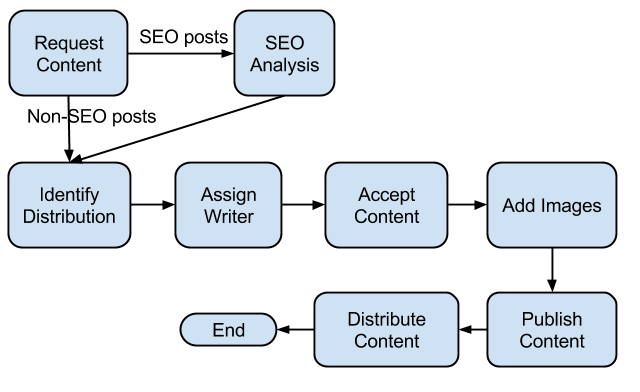What is Content Marketing Workflow?

Content marketing workflow is defined as the process of streamlining the series of steps involved in the planning, production, editing, distribution, and management of marketing content. The workflow contains a defined path that each content request flows through that takes it from conceptualization to execution.
We create a lot of content at Kissflow, but the process used to be rife with chaos. Quality was inconsistent, output was hit or miss, and many articles had not an apparent aim.Automate your content marketing workflow in 5 steps with Kissflow workflow software.
So we turned to Kissflow to create our own custom content marketing workflow.
Here’s what ours looks like:

1. Request Content & SEO Analysis
Several people can initiate a content request. It might come from the Managing Editor according to the editorial calendar, or it might be an emergency SEO request or the CEO might have a fundamental idea that needs to get up.
Most of our articles go through some on page SEO work before they are written, but a few don’t require it. So, we’ve designed the process to automatically filter non-SEO posts to the next step. This can also trigger if the SEO person initiates the request so that he/she doesn’t have to duplicate the work.
On the form, the SEO expert or Managing Director can add notes about if the SEO should be on page seo or offpage, the expected length of the article, and a due date. The keyword search volume gives an indication to the Managing Editor to determine if we are actually creating content that end-users are searching for. If the search volume is low then an assessment of whether it is a longtail keyword would be done.
2. Identify Distribution
This is a key piece that too many teams wait to think about until it is too late. You need to know where you are going to distribute the content outside of your blog.
At this step, the community evangelist identifies niche community forums and other watering holes along with their estimated traffic. This helps the Editor and Writer craft the message for a particular audience and gives the content more purpose and meaning than just quietly sitting on our blog.
3. Assign Writer and Accept the Content
The Managing Editor will edit the headline and SEO title as required and will give the writer a full brief on what to write about, including the tone and the right persona.
The writer gets an email from Kissflow and uploads a Google Docs link. From there, the Managing Editor and the writer can work out the final shape of the article.
From within Kissflow, the Managing Editor can also send notes and clarifications back to anyone else earlier in the workflow in case there is a change in plans for the article.
4. Add Images and Publish Content
Once the content is approved, our graphic designer gets to see the article and create or find the perfect visual addition. Then, in our case, the SEO expert is the one who finally publishes the article, adds the image, and makes sure all the SEO tags are in place.
5. Distribute Content
Finally, the Community Evangelist is notified that the post is live. He or she crafts some unique messages for different platforms to distribute the article. Before completing this step, the team also collects stats from their effort and uploads them into the form.
Adapting the Flow to Your Goals
This workflow works great for creating blogs for us, but we also use a similar one for web pages, video, and other creative content.
The workflow helped us reach some important goals.
- Our content was thematically all over the place.
Solution: In the form, we force the initiator to choose from a major theme.
- Keywords were sometimes an afterthought.
Solution: We added the keyword research in the form so the writer can start with those in mind rather than adding them later.
- The person distributing the articles couldn’t make a plan to market them until they were already published.
Solution: By including the distributor early on in the process, they were more informed of what content was on its way.
Identify the Roles
Lots of people play a part in generating blog posts as a part of our content marketing. While each role is ideally best done by a different person, startups may consider these as logical roles that are done by the same person, although it will likely be less effective.
- Managing Editor: This is the head of your content team who manages the editorial calendar and approves articles.
- SEO Analyst: This person identifies the best keywords to focus on for each article.
- Content Writer: You may use in-house or freelance writers. Our experience using platforms like Fiverr and UpWork has been very poor in our B2B marketing.
- Community Evangelist: This is the person who distributes the content in the right communities where your prospects and influencers hang out.
Your Flow
Each company has a different strategy and culture when it comes to content creation. When you look at our content creation workflow, you would likely want to make several changes and tweaks to match your needs. Luckily our Content Marketing Workflow App can be given free along with this blog post and can be modified and customized to match your needs 100%.